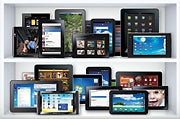What? Android tablet market share has skyrocketed almost 700 percent since a year ago, and the Apple iPad has plummeted to a meager 67 percent of the market? Why is it then, that iPads are everywhere, and the only place I see any other tablets is on the display table at Best Buy?
I'll tell you why. It's because the jump in Android tablet market share is an elusive myth like Big Foot or the Lochness Monster. It is a fantasy created from spinning stats so hard it could give you whiplash.
Contrary to hyperbolic reports, the iPad still dominates.One of my PCWorld peers wrote about stats reported from Strategy Analytics. That report claims Android tablet market share has jumped significantly to 27 percent, and that the iPad is down to only 67 percent of the tablet market. Let's take a closer look at the claims.
Shaky Math
It takes a lot of spin to make hyperbolic claims about Android tablets grabbing 27 percent of the market, or iPad market share dropping to 67 percent. The report, however, doesn't really say that. It is only focused on the most recent quarter, and it is only looking at the number of devices shipped.
If a new car model comes along and the manufacturer cranks out tens of thousands of them in a given quarter--enough to account for 27 percent of the vehicles manufactured that quarter--it doesn't necessarily mean that it sold any of them. It certainly doesn't mean that the new model suddenly accounts for 27 percent of the market compared against other manufacturers and models that have been sold for years.
Shipped or Sold?
One of the problems that seems to come up repeatedly when comparing Apple and Android in both smartphones and tablets is the distinction between the number of devices that have been shipped, and the number of devices that have actually been sold. Apple tends to report sales figures while its rivals like to talk about how many devices they have sitting in the Best Buy warehouse.
There are plenty of tablet rivals, but lets stick to comparing real-world sales, not who built the most.The HP TouchPad is a prime example. Just before pulling the plug on the webOS tablet and clearancing out the entire inventory for next to nothing, HP was touting numbers that it had shipped more than 250,000 tablets. Those reports were followed by complaints from Best Buy that it had only managed to sell about 25,000 total and a request that HP buy back the useless inventory.
Reporting the number of units "shipped" is like using the Fifth Amendment when testifying in court. Taking the fifth essentially implies guilt--because if you have nothing to hide there is no reason to hide behind the Fifth Amendment. Similarly, quoting the number of devices that have "shipped" is the same thing as saying "we're too embarrassed to tell you how few we've actually sold."
There is plenty of competition out there. It is virtually inevitable--just as a function of the sheer volume of tablet choices available--that Apple's overall share of the tablet market will drop over time. But, cherry-picking a single quarter and comparing the number of iPads sold against the number of other tablets that were manufactured and shipped isn't even an apples and oranges comparison--its like comparing apples and bicycles.
Let's keep it real. Android tablet makers may have ramped up production this past quarter, and it may be true that Android tablets account for 27 percent of the tablets manufactured during the past quarter, but what counts is how many have actually been purchased and are being used in the real world.
When it comes to that stat it's no contest--Apple owns the market for now. We'll see if the Amazon Kindle Fire can put a dent in that at all.



0 comments:
Post a Comment